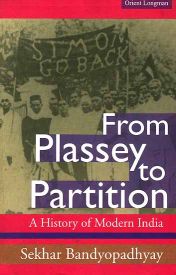From Plassey to Partition: A History of Modern India
Sekhar Bandyopadhyay
Bandyopadhyay, Sekhar;
From Plassey to Partition: A History of Modern India
Orient Longman, 2004, 523 pages
ISBN 8125025960, 9788125025962
topics: | history | british-india
Excerpts (notes)
Arguments for Partition of Bengal 1905
"Bengal united is a power. Bengal divided will pull in several different ways." - Home Secretary Herbert Risley, note of 7 Feb 1904 [p.253]
Curzon was initiated into the anti-Bengalee feelings of the colonial bureaucracy even before he became the viceroy... Congress is manipulated from Calcutta by its "best wirepullers and ... frothy orators". [Partition was intended ] as a means of destroying political opposition in this province. 251
first census of 1872: revealed large population of Muslims in Bengal - 49.2 percent of total. A clear geographic divide along the river bhagirathi - east of it (incl northern areas) were mostly Muslim, west mostly Hindu, and balanced in central Bengal.
Curzon's Proposal: Dacca would assume the character of a capital where Muslim interests would be strongly represented if not become predominant. No wonder, the Muslims in eastern Bengal gradually rallied around the partition scheme. 254
Presidency of Bengal was becoming too unwieldy - at one point its frontiers extended from Sutlej to Assam to Arakan (Burma). In 1874, Assam was separated w 3 mn people; and 3 Bengali speaking districts - Sylhet, Goalpara and Cachar added to it. Proposal to expand this region was proposed in 1897 etc.
In 1901 census, population of Bengal reached 78.5mn. Curzon's initial plans were "secretly expanded" through additions to the list of transferred districts. Announced on 19 Jul 1905 and implemented on 16 Oct: created * Eastern Bengal and Assam (new province), w Chittagong, Dacca and Rajshahi divisions and Hill Tippera, Malda and Assam. Populn: 31mn, w 18mn muslims and 12 mn hindus. * Bengal (remaining) : included Sambalpur and Ganjam and Vizagapatnam and parts of MP. populn 54 mn; 42mn hindu and 9 mn muslim; more oriya and hindi speakers than bengali.
Partition of Bengal : result of "colonial prejudice"
Arguments given for partition: closer access to a port (Chittagong) from
Assam, smaller populn -> administrative efficiency, all of Assam-Bengal
railways under a single administration etc.
Were seen to be fallacious - same goals would have been achieved more easily by
proposals mooted by civil servants and Congress-affiliated groups - such as a
partition along more linguistic lines than along religious (e.g. Sumit
Sarkar, Swadeshi movement in Bengal, 1973).
These proposals were rejected by Curzon because linguistic unity would
further consolidate the position of the Bengali population -
we should look for real reasons of artition in the political prejudices of
the colonial government. 253
But the partition, instead of dividing and weakening the Bengalees, further
united them through an anti-partition agitation, the Swadeshi movement, which
brought forth an unprecedented unified fervour from the Calcutta leaders to
the rural areas of East Bengal. 254
Swadeshi movement
1903: moderates seek to modify the proposals in the formative stages; start
prayers, pettitions and public meetings
1905 Jul 17: Surendranth Banerjea gives a call for the boycott of British
goods. Passed at a mass meeting in Calcutta town hall on 7 August.
Four trends (Sarkar 1973): moderate, constructive swadeshi, political
extremism, revolutionary terrorism. intermixed in time and space.
movement started mobilizing beyond the literate section of the population.
National education movement; emphasis on self-reliance, village-level
organisation and constructive programmes to develop indigenous or swadeshi
alternatives to foreign goods and institutions. amateurish attempts to
manufacture daily necessities.
- Bengal chemical started as a swadeshi enterprise in 1893.
- a porcelain factory in 1901.
arbitration courts and village administration:
Swadesh Bandhab samiti in Bakarganj district: claimed to have resolved 523
disputes through its 89 arbitration committees by Aug 1906.
National education movement
- Bhagabat Ghatuspathi of Satischandra Mukherjee (1895);
- Dawn society (1902-7)
- Saraswat Ayatan of Brahmabandhab Upadhyay (1902)
- Santiniketan (1901)
- Bengal national college and school (1906 august)
emphasis on non-political constructive programmes. Rabindranath was one of
the main ideologues of the constructive swadeshi movement.
By 1906 this trend was being criticized by political extremists like
Aurobindo Ghosh, Bepin Chandra Pal or Brahmabandhab Upadhyay, who argued that
without full freedom no real regeneration of national life was possible. The
movement's goal then broadened - not merely the abrogation of partition, but
complete independence or swaraj. Added abolition of unjust laws and violent
agitation if necessary to the two goals of boycott of Brit goods and
development of indigenous alternatives.
Religious revivalism became a main feature was a means to reach the masses -
Aurobindo Ghosh - Bhagavadgita as a source of inspiration. Hindu religious
symbols, usually shAkta imagery - frequently used. But this also alienated
the Muslims and failed to attract many vaishnavites - many lower-caste
peasants (Barbara Southard, 1980).
amitabha mukerjee (mukerjee [at-symbol] gmail) 2012 Apr 20
